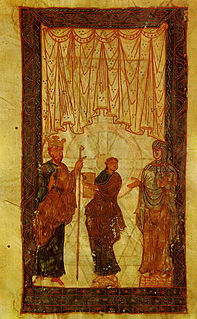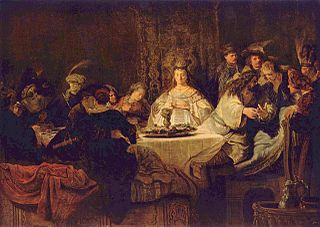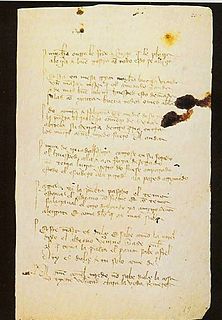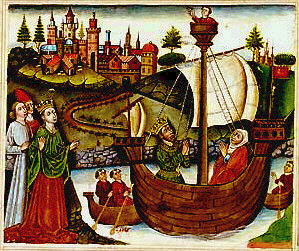
The Libro de los Juegos,, or Libro de axedrez, dados e tablas, was commissioned by Alfonso X of Castile, Galicia and León and completed in his scriptorium in Toledo in 1283, is an exemplary piece of Alfonso's medieval literary legacy.

Ferdinand I, called the Great, was the Count of Castile from his uncle's death in 1029 and the King of León after defeating his brother-in-law in 1037. According to tradition, he was the first to have himself crowned Emperor of Spain (1056), and his heirs carried on the tradition. He was a younger son of Sancho III of Navarre and Muniadona of Castile, and by his father's will recognised the supremacy of his eldest brother, García Sánchez III of Navarre. While Ferdinand inaugurated the rule of the Navarrese Jiménez dynasty over western Spain, his rise to preeminence among the Christian rulers of the peninsula shifted the locus of power and culture westward after more than a century of Leonese decline. Nevertheless, "[t]he internal consolidation of the realm of León–Castilla under Fernando el Magno and [his queen] Sancha (1037–1065) is a history that remains to be researched and written."

A riddle is a statement or question or phrase having a double or veiled meaning, put forth as a puzzle to be solved. Riddles are of two types: enigmas, which are problems generally expressed in metaphorical or allegorical language that require ingenuity and careful thinking for their solution, and conundra, which are questions relying for their effects on punning in either the question or the answer.
Beli Mawr was an ancestor figure in Middle Welsh literature and genealogies. He is the father of Cassivellaunus, Arianrhod, Lludd Llaw Eraint, Llefelys, and Afallach. In certain medieval genealogies he is listed as the husband of Anna, cousin of Mary, mother of Jesus. According to the Welsh Triads, Beli and Dôn were the parents of Arianrhod, but the mother of Beli's other children—and the father of Dôn's other children—is not mentioned in the medieval Welsh literature. Several royal lines in medieval Wales traced their ancestry to Beli. The Mabinogi names Penarddun as a daughter of Beli Mawr, but the genealogy is confused; it is possible she was meant to be his sister rather than daughter.

Cunobeline was a king in pre-Roman Britain from about AD 10 until about AD 40. He is mentioned in passing by the classical historians Suetonius and Dio Cassius, and many coins bearing his inscription have been found. He appears to have controlled a substantial portion of south-eastern Britain, and is called "King of the Britons" by Suetonius. Cunobeline appears in British legend as Cynfelyn (Welsh), Kymbelinus or Cymbeline, as in the play by William Shakespeare.

Gonzalo de Berceo was a Castilian poet born in the Riojan village of Berceo, close to the major Benedictine monastery of San Millán de la Cogolla. He is celebrated for his poems on religious subjects, written in a style of verse which has been called Mester de Clerecía, shared with more secular productions such as the Libro de Alexandre, the Libro de Apolonio. He is considered the first Castilian poet known by name.

The Book of Good Love, considered to be one of the masterpieces of Spanish poetry, is a semi-biographical account of romantic adventures by Juan Ruiz, the Archpriest of Hita, the earliest version of which dates from 1330; the author completed it with revisions and expansions in 1343.
Lupus I was the Duke of Gascony and Aquitaine from about 670. His reign may have lasted a few years or longer. He is often considered the progenitor of the Gascon dynasty of Lupus II and the Aquitainian dynasty the Eudonians.
Lientur was the Mapuche toqui from 1618 to 1625. He was the successor to Loncothegua. Lientur with his vice toqui Levipillan was famed for his rapid malóns or raids. Because of his ability to slip back and forth over the Spanish border between its fortresses and patrols and raid deep into Spanish territory north of the Bio-Bio River without losses he was called the Wizard by the Spanish.

The Libro de Alexandre is a medieval Spanish epic poem about Alexander the Great written between 1178 and c. 1250 in the mester de clerecía. It is largely based on the Alexandreis of Walter of Châtillon, but also contains many fantastical elements common to the Alexander romance. It consists of 2,675 stanzas of cuaderna vía and 10,700 lines.
John (Johannes) Hennon was a Dutch medieval philosopher in the late Scholastic tradition. He was from Nijmegen, and studied at the University of Paris, where he received his magister artium and baccalaureus formatus in sacra pagina (1463).
Lambertus de Monte, also Lambertus de Monte Domini or Lambert of Cologne, was a medieval scholastic and Thomist.
Butapichón or Butapichún or Putapichon was the Mapuche toqui from 1625 to 1631, as successor to Lientur. After the death of Quepuantú in 1632 he became toqui once again from 1632 to 1634.
Sérgio von Puttkammer, best known by the stage name Viana Júnior, was a Brazilian comedian and actor.

Los chiflados del rock and roll is a 1957 Mexican musical comedy film, directed by José Díaz Morales, starring Luis Aguilar, Agustín Lara, and Pedro Vargas. The supporting cast includes Eulalio González, Lina Salomé, Delia Magaña, and Rosita Arenas.
Juan de Celaya was a Spanish mathematician, physicist, cosmologist, philosopher and theologian. He was a member of the so-called Calculators, using ideas from Merton College. He is known for his work on motion and in logic.

The Book of the Knight Zifar is the earliest fictional adventure tale in prose in the Spanish language. It was written around 1300, probably by a cleric of Toledo, Ferrand Martínez, who is mentioned in the prologue. The book has much affinity with contemporary works of chivalric romance.

Medieval Spanish literature consists of the corpus of literary works written in medieval Spanish between the beginning of the 13th and the end of the 15th century. Traditionally, the first and last works of this period are taken to be respectively the Cantar de Mio Cid, an epic poem whose manuscript dates from 1207, and La Celestina (1499), a work commonly described as transitional between the medieval period and the Renaissance.
The Libros del saber de astronomía del rey Alfonso X de Castilla, "Books of wisdom of astronomy of King Alfonso X of Castile", is a series of books of the medieval period, composed during the reign of Alfonso X of Castile. They describe the celestial bodies and the astronomical instruments existing at the time. The collection is a group of treatises on astronomical instruments, like the celestial sphere, the spherical and plane astrolabe, saphea, and universal plate for all latitudes, for uranography or star cartography that can be used for casting horoscopes. The purpose of the rest of the instruments, the quadrant of the type called vetus, sundial, clepsydras, is to determine the time, which was also needed to cast the horoscope. The king looked for separate works for the construction and use of each device.









